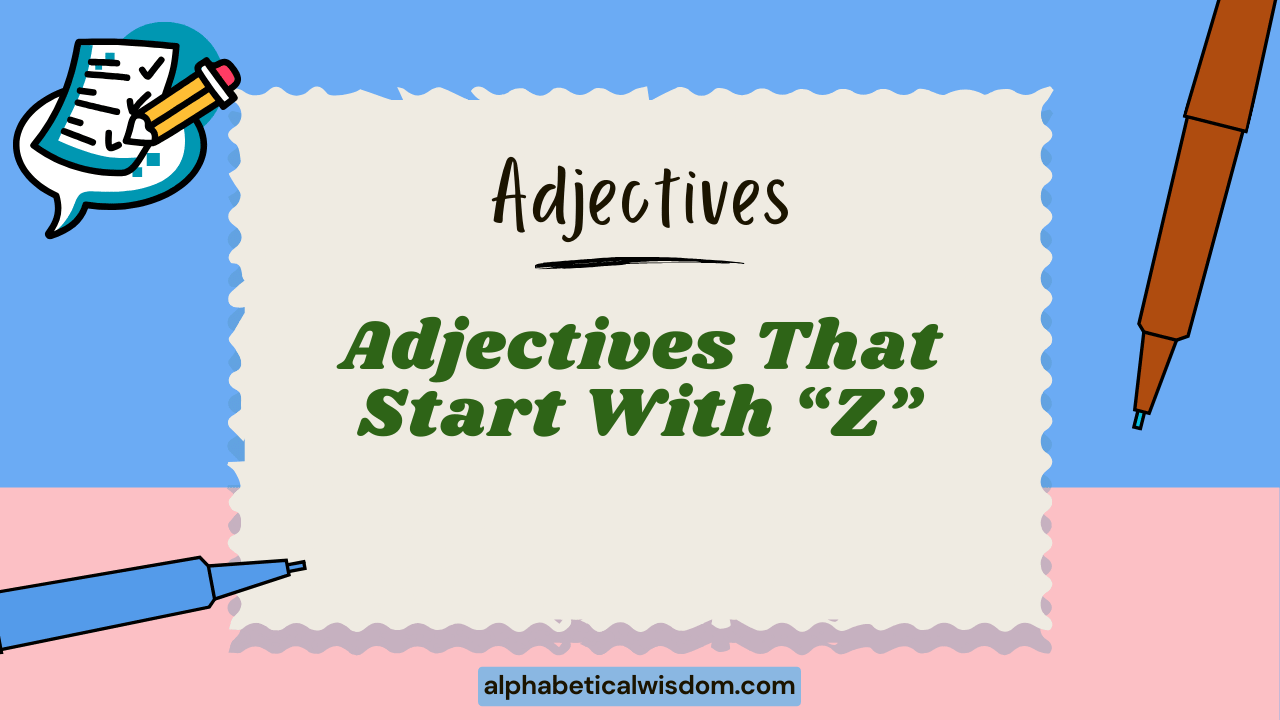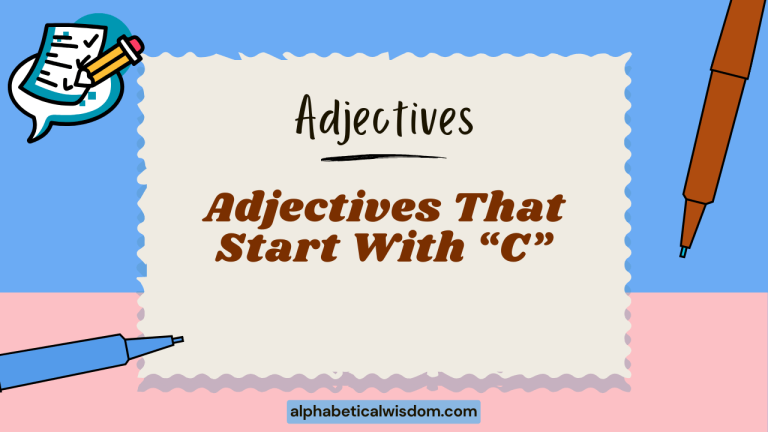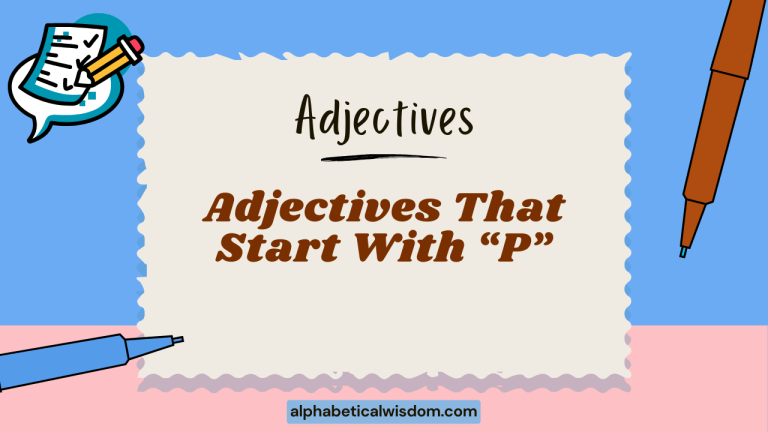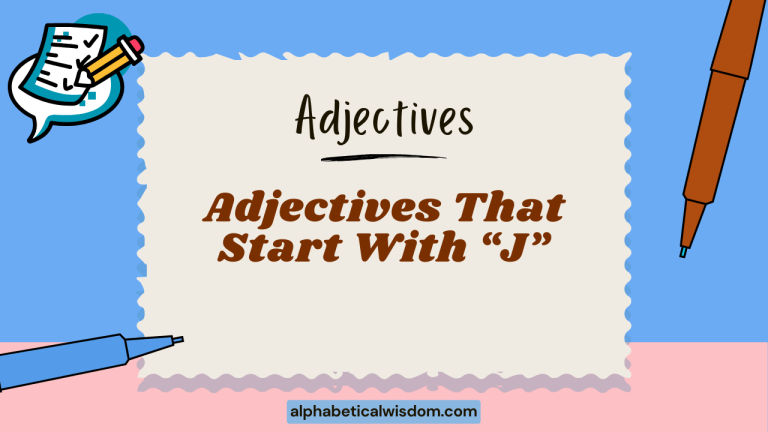Adjectives That Start With Z: A Comprehensive Grammar Guide
Mastering adjectives is crucial for enriching your writing and speaking skills. Adjectives that start with the letter “Z,” while fewer in number compared to other letters, add a unique flavor and precision to your language.
This article provides an in-depth exploration of adjectives starting with “Z,” covering their definitions, usage, and practical applications. Whether you are a student, a language enthusiast, or a professional writer, this guide will help you expand your vocabulary and use these adjectives effectively.
Table of Contents
- Introduction
- Definition of Adjectives
- Structural Breakdown of Adjectives
- Types and Categories of Adjectives Starting with Z
- Examples of Adjectives Starting with Z
- Usage Rules for Adjectives Starting with Z
- Common Mistakes When Using Adjectives Starting with Z
- Practice Exercises
- Advanced Topics
- FAQ: Frequently Asked Questions
- Conclusion
Definition of Adjectives
An adjective is a word that modifies a noun or pronoun, providing more information about it. Adjectives describe the qualities, characteristics, or attributes of the nouns they modify.
They answer questions like “Which one?”, “What kind?”, or “How many?” about the noun. Understanding adjectives is fundamental to constructing detailed and vivid sentences.
Adjectives can be classified based on their function and the type of information they provide. Some common types include descriptive adjectives, which describe the qualities of a noun (e.g., beautiful, tall); quantitative adjectives, which indicate quantity (e.g., few, many); and demonstrative adjectives, which point out specific nouns (e.g., this, that).
Adjectives play a crucial role in making language more precise and expressive. They allow us to convey nuanced meanings and create vivid imagery in our writing and speech.
Without adjectives, our communication would be bland and lack detail, making it harder to understand and appreciate the subject being discussed.
Structural Breakdown of Adjectives
Adjectives typically precede the noun they modify. For example, in the phrase “a zealous advocate,” the adjective “zealous” comes before the noun “advocate.” However, adjectives can also follow a linking verb, such as “is,” “are,” “was,” “were,” “seems,” or “appears.” In this case, the adjective describes the subject of the sentence, acting as a subject complement.
Adjectives can also be modified by adverbs. An adverb placed before an adjective intensifies or modifies the adjective’s meaning. For example, in the phrase “extremely zealous,” the adverb “extremely” intensifies the adjective “zealous.” This allows for even greater precision in describing the noun.
The structure of adjectives themselves can vary. Some adjectives are simple words, while others are formed by adding prefixes or suffixes to other words.
For instance, adding the suffix “-ous” to the noun “zeal” creates the adjective “zealous.” Understanding these structural elements can help in recognizing and using adjectives effectively.
Types and Categories of Adjectives Starting with Z
Descriptive Adjectives
Descriptive adjectives describe the qualities or characteristics of a noun. They provide details that help create a clearer picture of the noun being described. Examples of descriptive adjectives starting with “Z” include “zany,” “zealous,” and “zigzag.”
Proper Adjectives
Proper adjectives are formed from proper nouns and are always capitalized. While there aren’t many common proper adjectives starting with “Z,” they can be created from place names or names of people or things. For example, “Zambian” (from Zambia) is a proper adjective.
Compound Adjectives
Compound adjectives are formed by combining two or more words, often with a hyphen. These adjectives act as a single unit to describe a noun. While less common with the letter “Z,” they can still be found or created in specific contexts, such as a “zero-tolerance” policy.
Quantitative Adjectives
Quantitative adjectives indicate the quantity or amount of a noun. These adjectives answer the question “How many?” or “How much?” Although rare with the letter “Z,” the term “zero” can function as a quantitative adjective in certain contexts, such as “zero defects.”
Examples of Adjectives Starting with Z
This section provides numerous examples of adjectives starting with “Z” used in sentences. The examples are categorized to illustrate the different ways these adjectives can be used and to provide context for their meanings.
Table 1: Examples of “Zany” in Sentences
The following table provides examples of the adjective “zany” used in various sentences to illustrate its meaning and usage. “Zany” typically means amusingly unconventional or eccentric.
| Sentence | Explanation |
|---|---|
| The comedian’s zany antics had the audience roaring with laughter. | Describes the comedian’s behavior as amusingly unconventional. |
| Her zany sense of humor always lightens the mood. | Indicates that her humor is eccentric and entertaining. |
| The children enjoyed the zany cartoon characters. | Describes the characters as amusingly strange and unconventional. |
| He is known for his zany ideas and creative solutions. | Describes the ideas as unconventional and amusingly strange. |
| The party was filled with zany decorations and costumes. | Indicates that the decorations and costumes were eccentric and fun. |
| Her zany personality made her stand out in the crowd. | Describes her personality as uniquely eccentric and amusing. |
| The director encouraged the actors to be more zany in their performances. | Suggests the actors should adopt a more eccentric and unconventional style. |
| The zany plot of the movie kept everyone entertained. | Describes the plot as amusingly strange and unpredictable. |
| They came up with a zany plan to surprise their friend. | Indicates the plan was unconventional and amusingly eccentric. |
| The zany illustrations in the book added to its charm. | Describes the illustrations as amusingly strange and delightful. |
| His zany approach to problem-solving often yields unexpected results. | Describes his approach as unconventional and amusingly eccentric. |
| The zany puppet show was a hit with the kids. | Indicates the puppet show was amusingly strange and entertaining. |
| She has a zany way of looking at the world. | Describes her perspective as uniquely eccentric and amusing. |
| The zany characters in the play provided comic relief. | Indicates the characters were amusingly strange and provided entertainment. |
| They decorated the office with zany artwork. | Describes the artwork as eccentric and amusingly unconventional. |
| His zany behavior at the party made everyone laugh. | Indicates his behavior was amusingly strange and entertaining. |
| The zany lyrics of the song were quite memorable. | Describes the lyrics as amusingly strange and catchy. |
| She wore a zany hat to the costume party. | Indicates the hat was eccentric and amusingly unconventional. |
| The zany special effects in the movie were impressive. | Describes the special effects as amusingly strange and well-done. |
| He told a zany story that had everyone in stitches. | Indicates the story was amusingly strange and very funny. |
| The zany combination of flavors in the dish was surprisingly delicious. | Describes the flavor combination as unconventional and amusingly strange, yet tasty. |
| Her zany outfits always make a statement. | Indicates that her outfits are eccentric, unconventional, and attention-grabbing. |
| The zany game show was unlike anything I’d ever seen. | Describes the game show as uniquely eccentric and amusingly strange. |
Table 2: Examples of “Zealous” in Sentences
The following table provides examples of the adjective “zealous” used in various sentences to illustrate its meaning and usage. “Zealous” typically means having or showing great energy or enthusiasm in pursuit of a cause or objective.
| Sentence | Explanation |
|---|---|
| The zealous volunteers worked tirelessly to help the community. | Describes the volunteers as being enthusiastic and dedicated. |
| He was a zealous advocate for environmental protection. | Indicates that he passionately supports environmental protection. |
| The zealous fans cheered loudly for their team. | Describes the fans as being enthusiastic and supportive. |
| Her zealous approach to her studies helped her succeed. | Indicates that her enthusiasm and dedication contributed to her success. |
| The zealous detective pursued the case relentlessly. | Describes the detective as being determined and enthusiastic in his pursuit. |
| He is a zealous supporter of animal rights. | Indicates that he is passionately committed to animal rights. |
| The zealous missionaries traveled to remote areas. | Describes the missionaries as being enthusiastic and dedicated to their mission. |
| Her zealous dedication to her work is admirable. | Indicates that her enthusiasm and commitment are praiseworthy. |
| The zealous activists organized a protest. | Describes the activists as being enthusiastic and passionate about their cause. |
| He is a zealous collector of rare books. | Indicates that he is very enthusiastic and passionate about collecting rare books. |
| The zealous students participated actively in class. | Describes the students as being enthusiastic and engaged in the class. |
| Her zealous efforts to improve the community were recognized. | Indicates that her enthusiastic and dedicated work was acknowledged. |
| The zealous athlete trained hard for the competition. | Describes the athlete as being enthusiastic and dedicated to their training. |
| He is a zealous defender of free speech. | Indicates that he passionately supports and protects free speech. |
| The zealous volunteers cleaned up the park. | Describes the volunteers as being enthusiastic and dedicated to their task. |
| Her zealous commitment to the project ensured its success. | Indicates that her enthusiastic and dedicated involvement guaranteed the project’s success. |
| The zealous researcher worked day and night in the lab. | Describes the researcher as being enthusiastic and dedicated to their work. |
| He is a zealous advocate for education reform. | Indicates that he passionately supports and promotes education reform. |
| The zealous supporters rallied behind their candidate. | Describes the supporters as being enthusiastic and dedicated to their candidate. |
| Her zealous pursuit of her dreams inspired others. | Indicates that her enthusiastic and dedicated efforts motivated others. |
| The company adopted a zero-tolerance policy towards harassment. | Describes the policy as one that does not allow any instances of harassment. |
| The team aimed for zero defects in their manufacturing process. | Indicates the team wanted to eliminate all defects. |
| The government set a goal of achieving zero carbon emissions. | Describes the goal as eliminating all carbon emissions. |
Table 3: Examples of “Zigzag” in Sentences
The following table provides examples of the adjective “zigzag” used in various sentences to illustrate its meaning and usage. “Zigzag” typically means having or consisting of a series of short, sharp angles or lines.
| Sentence | Explanation |
|---|---|
| The zigzag path led up the steep mountain. | Describes the path as having a series of sharp turns. |
| The lightning flashed in a zigzag pattern across the sky. | Indicates the lightning moved in a series of sharp angles. |
| The artist painted a zigzag design on the wall. | Describes the design as having a pattern of sharp angles. |
| The car swerved in a zigzag motion to avoid the obstacle. | Indicates the car moved erratically with sharp turns. |
| The river flowed in a zigzag course through the valley. | Describes the river’s path as having many sharp bends. |
| The tailor sewed a zigzag stitch along the seam. | Indicates the stitch had a pattern of short, sharp angles. |
| They created a zigzag border around the garden. | Describes the border as having a pattern of sharp turns. |
| The road followed a zigzag route up the hill. | Indicates the road had a series of sharp turns. |
| The pattern on the fabric was a zigzag arrangement of colors. | Describes the pattern as having a series of sharp angles and colors. |
| The skier navigated the zigzag course with skill. | Indicates the course had a series of sharp turns. |
| The fence was built in a zigzag fashion to provide stability. | Describes the fence as having a pattern of sharp angles for support. |
| The child drew a zigzag line across the paper. | Indicates the line had a series of short, sharp angles. |
| The hiker followed the zigzag trail up the mountain. | Describes the trail as having a series of sharp turns. |
| The dancer moved in a zigzag pattern across the stage. | Indicates the dancer moved with a series of sharp turns and angles. |
| The path through the maze was full of zigzag turns. | Describes the path as having many sharp turns and angles. |
| The quilt featured a zigzag design made of colorful patches. | Indicates the design had a pattern of sharp angles and colors. |
| The rollercoaster climbed a steep zigzag track. | Describes the track as having a series of sharp turns and angles. |
| The artist created a zigzag mural on the building’s facade. | Indicates the mural had a pattern of sharp angles and lines. |
| The race car driver expertly maneuvered through the zigzag course. | Describes the course as having a series of sharp turns. |
| The banner was decorated with a zigzag border. | Indicates the border had a pattern of sharp angles and lines. |
Usage Rules for Adjectives Starting with Z
When using adjectives that start with “Z,” it’s important to follow standard grammatical rules for adjective placement. Generally, adjectives precede the noun they modify.
However, they can also follow linking verbs. Pay attention to the specific meaning and context to ensure correct usage.
Adjectives should agree in number with the nouns they modify. However, this rule primarily applies to demonstrative adjectives (this, that, these, those) and quantitative adjectives that specify a number. For most adjectives starting with “Z,” this isn’t a concern because they describe qualities rather than quantities.
When using multiple adjectives to describe a noun, follow the correct order of adjectives. The general order is: quantity, opinion, size, age, shape, color, origin, material, and purpose.
While it’s unlikely to use multiple adjectives starting with “Z” in a single phrase, understanding this order is helpful for general adjective usage.
Common Mistakes When Using Adjectives Starting with Z
One common mistake is misinterpreting the meaning of an adjective. For example, using “zany” when you mean “zealous” can completely change the meaning of your sentence. Always double-check the definition to ensure you’re using the correct word.
Another mistake is incorrect placement of adjectives. While adjectives usually precede the noun, placing them after can sometimes create a different emphasis or meaning, especially when using linking verbs.
Be mindful of the intended meaning and place the adjective accordingly.
A less common mistake, but still important to avoid, is using an adjective inappropriately based on context. For example, using “zigzag” to describe a personality trait doesn’t make sense; it’s typically used to describe patterns or paths. Always consider the context and ensure the adjective is appropriate for the noun it modifies.
Here are some examples of correct vs. incorrect usage:
| Incorrect | Correct | Explanation |
|---|---|---|
| The advocate was zany for justice. | The advocate was zealous for justice. | “Zealous” means enthusiastic, which is more appropriate here. |
| He walked a zealous path through the woods. | He walked a zigzag path through the woods. | “Zigzag” describes a path with sharp turns, fitting the context. |
| Her performance was zealous and strange. | Her performance was zany and strange. | “Zany” means amusingly unconventional, aligning with “strange” in this context. |
Practice Exercises
Test your understanding of adjectives that start with “Z” with these practice exercises. Fill in the blanks with the appropriate adjective from the list provided. Adjective options: zany, zealous, zigzag, zero.
Exercise 1
| Question | Answer |
|---|---|
| 1. The comedian’s ______ jokes had the audience laughing uncontrollably. | zany |
| 2. He was a ______ supporter of the campaign, donating both time and money. | zealous |
| 3. The road wound in a ______ pattern up the mountain. | zigzag |
| 4. The company has a ______ tolerance policy for any form of discrimination. | zero |
| 5. Her ______ dedication to the cause was truly inspiring. | zealous |
| 6. The artists used a ______ pattern to decorate the walls. | zigzag |
| 7. The ______ antics of the clowns entertained the children. | zany |
| 8. The team worked to achieve ______ defects in their manufacturing process. | zero |
| 9. His ______ approach to problem-solving often leads to creative solutions. | zany |
| 10. The ______ fans cheered for their team throughout the entire game. | zealous |
Exercise 2
Rewrite the following sentences using an adjective starting with “Z” to add more detail and description.
| Question | Answer |
|---|---|
| 1. The path through the forest had many sharp turns. | The path through the forest was a zigzag trail. |
| 2. She was a very enthusiastic advocate for animal rights. | She was a zealous advocate for animal rights. |
| 3. The show was amusingly unconventional and eccentric. | The show was zany. |
| 4. The policy did not allow any instances of tardiness. | The policy had zero tolerance for tardiness. |
| 5. His support for the team was very enthusiastic. | His support for the team was zealous. |
| 6. The route up the mountain had a lot of sharp turns. | The route up the mountain was zigzag. |
| 7. The performance was strange and unconventional | The performance was zany. |
| 8. There were no errors in the entire report. | There were zero errors in the entire report. |
| 9. Her dedication to the project was very strong. | Her dedication to the project was zealous. |
| 10. The design on the fabric had many sharp turns. | The design on the fabric was zigzag. |
Advanced Topics
For advanced learners, exploring the etymology of adjectives starting with “Z” can provide deeper insights into their meanings and usage. Understanding where these words come from can help you appreciate their nuances and use them more effectively.
For instance, “zealous” comes from the Greek word “zelos,” meaning fervor or passion.
Another advanced topic is the use of these adjectives in figurative language, such as metaphors and similes. For example, describing someone’s energy as “zigzag” can create a vivid image of erratic or unpredictable behavior.
Similarly, comparing someone’s dedication to a cause as “zealous” can emphasize their unwavering commitment.
Exploring the historical context in which these adjectives were first used can also be enlightening. Understanding how their meanings have evolved over time can provide a richer understanding of their current usage.
This can be particularly useful for writers and language enthusiasts who want to use these words with precision and impact.
FAQ: Frequently Asked Questions
- What is the primary function of an adjective?
The primary function of an adjective is to modify a noun or pronoun, providing more information about it. Adjectives describe the qualities, characteristics, or attributes of the nouns they modify, answering questions like “Which one?”, “What kind?”, or “How many?”
- Can adjectives follow the noun they modify?
Yes, adjectives can follow the noun they modify, especially when used with linking verbs such as “is,” “are,” “was,” “were,” “seems,” or “appears.” In this case, the adjective acts as a subject complement, describing the subject of the sentence rather than directly modifying the noun.
- How do you use multiple adjectives in a sentence?
When using multiple adjectives to describe a noun, follow the correct order of adjectives: quantity, opinion, size, age, shape, color, origin, material, and purpose. Separate adjectives of equal rank with commas, but do not use a comma between the last adjective and the noun.
- What is a descriptive adjective?
A descriptive adjective is an adjective that describes the qualities or characteristics of a noun. It provides details that help create a clearer picture of the noun being described. Examples include “zany,” “zealous,” and “zigzag.”
- What is a proper adjective?
A proper adjective is an adjective formed from a proper noun and is always capitalized. Examples include “Zambian” (from Zambia). They describe something related to that proper noun.
- Can “zero” be used as an adjective?
Yes, “zero” can be used as an adjective, particularly as a quantitative adjective. It indicates the absence of something, such as in the phrase “zero tolerance” or “zero defects.”
- What does the adjective “zany” mean?
The adjective “zany” means amusingly unconventional or eccentric. It is used to describe something or someone that is playfully odd or strange in a way that is entertaining.
- What does the adjective “zealous” mean?
The adjective “zealous” means having or showing great energy or enthusiasm in pursuit of a cause or objective. It describes someone who is passionately committed and dedicated to something.
- What does the adjective “zigzag” mean?
The adjective “zigzag” means having or consisting of a series of short, sharp angles or lines. It describes a pattern or path that alternates sharply from side to side.
- How can understanding the etymology of adjectives help?
Understanding the etymology of adjectives can provide deeper insights into their meanings and usage. Knowing where a word comes from can help you appreciate its nuances and use it more effectively, as well as understand its historical context.
Conclusion
Adjectives that start with the letter “Z” may be few, but they are powerful tools for adding specificity and color to your language. Mastering these words—such as zany, zealous, and zigzag—can significantly enhance your ability to express yourself clearly and creatively. By understanding their definitions, usage rules, and common mistakes, you can confidently incorporate them into your writing and speech.
Continue practicing with these adjectives and exploring their various contexts. The more you use them, the more natural they will become in your vocabulary.
Don’t be afraid to experiment and find new ways to use these words to make your language more vivid and engaging. Happy learning!






